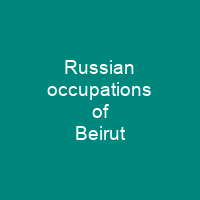Beirut’s Unlikely Occupation: A Tale of Russo-Turkish Conflict
Imagine a city, once under the strict control of the Ottoman Empire for over 250 years, suddenly finding itself in the hands of an unexpected power. That’s exactly what happened to Beirut during the Russo-Turkish War of the late 18th century. How did this happen? And why does it matter today?
The Rise of Russian Naval Power
It all began with Russia’s newly formed Mediterranean Fleet, led by Orlov and commanded by Admiral Grigory Spiridov. This fleet sailed from Copenhagen in 1769, setting the stage for a series of events that would change Beirut’s history forever. By March 1770, they were off the southern Morea, where the Orlov revolt was brewing. The Russian squadrons soon found themselves involved in various bombardments and troop landings across the region.
The Battle of Chesma: A Turning Point
One of the most significant battles was the crushing defeat of a Turkish fleet at the Battle of Chesma on July 7, 1770. This victory gave Russia naval command over the Mediterranean for the remainder of the war. With this newfound power, they could project their influence far beyond their borders.
Ali Bey’s Quest for Alliance
Meanwhile, in Egypt, Ali Bey al-Kabir was facing his own challenges. He dispatched an army to Palestine and soon realized he needed allies. In December 1771, he sent an Armenian envoy named Yaqub to meet with Orlov on the Aegean island of Paros. The offer was accepted by Catherine II, but it came too late as Ali Bey had already fled Egypt.
The Siege and Bombardment of Beirut
Despite this setback, the Russian squadron arrived off Beirut’s coast in June 1772. They found a city controlled by the Druze and decided to block their port and preoccupy them. The force consisted of two frigates, four polaccas, five half-galleys, and four xebecs, along with an infantry division made up of Greek and Albanian mercenaries.
The bombardment began on June 18, sinking Ottoman ships in the port. After receiving additional payment from Yusuf Shihab, the Russians left on June 28. The Ottomans ceded Beirut to Shihab’s Mount Lebanon Emirate shortly after their departure.
Further Occupation and Departure
The Russian occupation of Beirut marked a significant moment in history. It was the first time an Arab city came under foreign rule, and it wasn’t until 1774 that the Russians left, leaving behind Albanian mercenaries who guarded Mansur and occupied the town.
Aftermath and Legacy
Jazzar fortified Beirut and declared independence from Shihab. Zahir faced retribution for his wartime alliances under the Treaty of Küçük Kaynarca. He was killed in August 1775 during a siege of Acre by Ottoman forces, led by Egypt’s Abu al-Dahab. Shihab was quickly pardoned and pressured into surrendering Beirut in 1776 due to heavy taxation by Jazzar.
Beirut’s occupation by Russian forces was a pivotal moment that set the stage for future geopolitical developments. It marked the first time an Arab city came under foreign rule, and it challenged the long-standing dominance of the Ottoman Empire. This event is still debated among historians about its significance in modern Cold War-era assistance to national liberation movements.

You want to know more about Russian occupations of Beirut?
This page is based on the article Russian occupations of Beirut published in Wikipedia (retrieved on November 27, 2024) and was automatically summarized using artificial intelligence.







